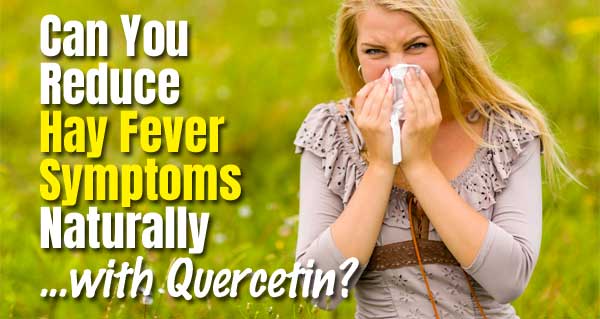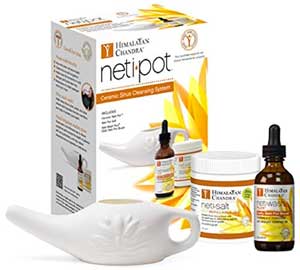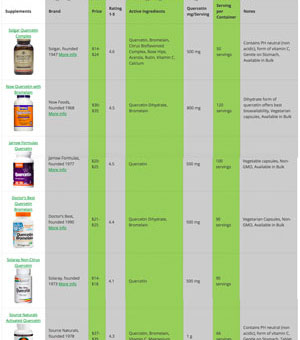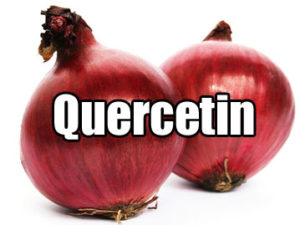Many people suffer from seasonal allergies. Not only can they make us feel awful, they can interfere with our everyday activities too. Some people have switched to natural quercetin for hay fever because traditional allergy medications make them feel drowsy. Plus, they want to avoid taking drugs because some prescriptions can cost over $200 per month.
Why Do We Get Hay Fever and What are the Symptoms?
MedicineNet explains that allergic rhinitis (or hay fever) occurs when we inhale plant proteins (pollen). Many trees, grasses and weeds produce extremely small, light, dry protein particles that get blown around in the wind, which we then inhale.

Note: However, you can also have allergic symptoms from cosmetics, laundry detergent, cigarette smoke, pet dander, perfumes, dust mites, mold and cleaning products (source).
In other words, you can avoid outdoor plant triggers and still experience symptoms by staying “safely” indoors.
According to Homeopathy Plus, allergic responses associated with hay fever include sneezing, stuffy or running nose, itching, headaches, asthma, watery eyes, post nasal drip and fogginess.

Why Should We Use Food and Quercetin for Hay Fever?
Unfortunately, over-the-counter antihistamines typically come with a variety of different unattractive side effects. In addition to drowsiness, people frequently experience headaches, dizziness, blurred vision, dry mouth, confusion, dry mouth and constipation.
 Therefore, they suggest managing hay fever symptoms with food, homeopathy and other simple home remedies. For example, drink plenty of water, rinse your sinuses with a neti pot and coat the inside of your nostrils with an ointment.
Therefore, they suggest managing hay fever symptoms with food, homeopathy and other simple home remedies. For example, drink plenty of water, rinse your sinuses with a neti pot and coat the inside of your nostrils with an ointment.
In addition, eating foods like onion, garlic and local raw honey can help alleviate symptoms and minimize allergic reactions. Also, consider using spices like horseradish, mustard, chillies and fenugreek.
Which Quercetin to Use for Hay Fever?
 You can get quercetin by eating certain foods, like apples, onions or capers. Alternatively, some people choose to supplement with quercetin in the form of tablets or capsules.
You can get quercetin by eating certain foods, like apples, onions or capers. Alternatively, some people choose to supplement with quercetin in the form of tablets or capsules.
Note: As mentioned in the video above, you want to choose a highly absorbable form of quercetin. For example, Bioactive Quercetin or Quercetin Dihydrate.
Supplements in these forms give you the most antioxidant-boosting power for the money. Plus, many of them include additional ingredients that help enhance quercetin’s immune-boosting activity (ie vitamin C, bromelain or magnesium).
According to Dr Lisa Lewis, ND, allergies are often associated with weak adrenal glands, immune system and digestive functions.
Therefore, eating healthy foods can help reduce allergic reactions. Plus, you also want to remove certain foods that you may have sensitivities to.
She recommends eating a moderately low fat, high complex carbohydrate diet and drinking 75 ounces of water. In addition, she suggests eliminating dairy, bananas, citrus, chocolate, peanuts, red meat, alcohol, sugar, wheat and caffeine.
Summary on Using Quercetin for Hay Fever:
 Some people find that keeping the immune system strong by using food, exercise, sleep and natural supplements works better than prescription medications. A healthy immune system can sometimes fight off “attacks” and help prevent allergic reactions from occurring in the first place.
Some people find that keeping the immune system strong by using food, exercise, sleep and natural supplements works better than prescription medications. A healthy immune system can sometimes fight off “attacks” and help prevent allergic reactions from occurring in the first place.
Note: Quercetin does not provide an instant allergy solution. It can take several weeks for the antioxidant power of quercetin to build up in the body and take effect. Therefore, opt for more potent formulas and plan on taking it 4-6 weeks before you expect to see results.
